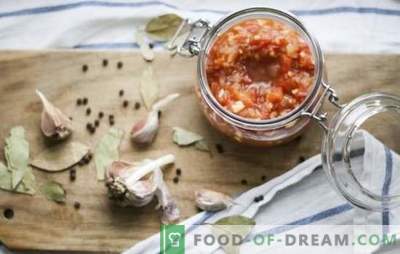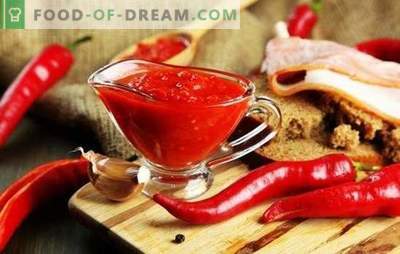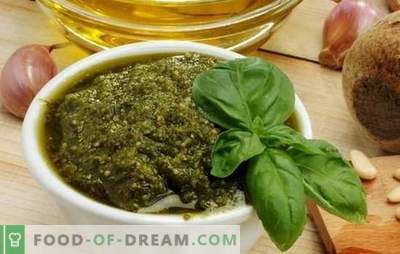
The word adjika has Abkhaz roots. The basis of the best adzhika for the winter in any kitchen of the world is not hot pepper, but the love of spicy food.
The best adjika for the winter - the general principles of preparation.
Variations of the best adzhika for the winter are present in the national cuisines of many nations, even in those countries where there is no winter, and there is no need to look for a recipe for the best adzhika for the winter. Components of spicy seasoning have a local flavor and are associated exclusively with the climate, causing the growth of ingredients in a particular area.
Kinds of the best adzhika for the winter
The traditional idea of the best adjika for the winter involves the preparation of a rather thick, spicy sauce. But spicy seasoning has become so widespread that it has become a favorite addition to food, including among people who, for various reasons, prefer to use spicy seasonings with a milder taste. Likely, so there was a “sweet” adzhika. Success in cooking enjoy a mixture of dry peppers and spices, called "dry adzhika."
Preparing dishes and vegetables for the best adzhika for the winter
For winter harvesting, there are some general rules, the observance of which allows each family to be provided with vitamin products until the new harvest.
The basic rule of canning is sterile dishes and carefully selected vegetables and fruits, so that the effort expended please with a jar of the best adzhika for the winter.
Glassware and lids must be sterilized without fail. Reliable and fast way: wash the cans in soda solution (1 tbsp. L / 1 l of water), rinse under running water, then put the dishes on a baking sheet and calcined in the oven at a maximum temperature of about 5 minutes. The time of roasting dishes in the microwave - 1-2 minutes Natural preservatives for the best adzhika for the winter
Fortunately, nature has provided humanity with natural preservatives in full, which greatly simplifies the task of storing winter preparations.
• Hot pepper - the main component of the best adzhika for the winter, is at the same time a great natural preservative.
• Salt. For conservation, you can not use vacuum or iodized salt - only the dining room (cooking), coarse salt: it contains sodium chloride, almost in its pure form. Additives in the form of synthetic iodine and other chemical preservatives contained in fine and very white salt are not suitable for blanks.
• Sugar. The property of sugar is a mystery of nature. An indispensable component for the fermentation reaction, it is also a preservative.
• Vinegar. For canning, unlike salt, you need to choose synthetic table vinegar (9%).
• Vegetable oil. In many recipes of the best adjika for winter, there is vegetable oil. If you can not do without it, then even refined oil should be calcined in a separate container before use in preservation.
• Garlic. Its antibacterial properties help to cope with many harmful microorganisms.
• To mitigate the effects of capsaicin in hot spices, tomatoes, cranberries, and other acidic ingredients are often used, containing acid, which is an additional preservative.
• Spices containing phytoncides and included in the composition of the best adzhika for the winter, not only increase the taste, but also help to preserve the “tasty” jar to the new harvest.
Thanks to the natural preservatives, which are at the same time the main ingredients of the best adzhika for the winter, the process of preparation and storage does not cause great difficulties. Most recipes for spicy seasoning do not need sterilization: it is enough to boil them and cork in sterile jars.
For each recipe of the best adzhika for the winter, there are separate rules for cooking, pasteurization and storage. But about this in more detail in the selection of the best adzhik for winter and summer, and to any dish. Using the recipes described below, you can make sure that the best adjika for the winter can cook not only in Abkhazia.
Recipe 1. The best adjika for winter in the old Russian recipes: cranberry gravy
Ingredients:
• Oregano - 1 tsp;
• Mint (pepper) - 0,010 g;
• Juniper (berries) - 0,030 g;
• Cloves - 0.005 g;
• Pepper “Spark” - 0,050 g;
• Garlic - 0.150 g;
• Onion - 0.250 g;
• Cranberries (or lingonberries) - 0.500 g;
• Honey - 0.150g;
• Water - 0,250 ml.
Preparation:
Ingredients as much as possible adapted to modern conditions.
Cranberries pass through a sieve. Add 0.250 ml of water to boiled skin and boil. Wash garlic, onion and other spices, peel, pound in a mortar and tie into a cloth (gauze). “Bag” and cranberry juice add to water and boil. Pull out the bag, add honey and boil down to a thickness similar to jelly.
Gravy packaged in sterile jars.
Why our ancestors cooked honey - is unknown, but the gravy is very combined with poultry meat baked in the oven.
Recipe 2. Best adjika for the winter - “Hrenovina”
This recipe has many names and many options. But the main ingredient is horseradish root.
Ingredients:
• Tomatoes - 0.500 kg;
• Hot pepper - 1 pod;
• Horseradish - 0.200 g;
• Garlic - 0.200 g;
• Salt and sugar - to taste;
• Refined oil - 0.100 ml.
Preparation:
Tomatoes to select, peel, wash and remove the peel. Horseradish chop on a grater. All ingredients shake in a blender.
Packed in sterile jars with a volume of not more than 0.200 ml. On top of the contents pour pre-calcined refined oil. Banks to cork.
Recipe 3. The best adjika for the winter in Mexican cuisine - “Salsa”
Ingredients:
• Tomatoes - 0,500 g;
• Onions (bulb) - 0.100 g;
• Garlic - 5 small cloves;
• Chili pepper - 0.075 g;
• Lemon juice - 0.050 ml;
• Salt to taste; • Sugar - to taste;
• Cilantro, parsley (fresh greens) - 0.050 g.
Preparation:
Finely chop the prepared vegetables. Add lemon juice, sugar and salt, mix in a blender. Cook on low heat for 10 minutes. Ready salsa packaged in banks, a volume of 0.200 ml.
Recipe 4. The best adjika for the winter in Italian cuisine - delicate “Pesto”
Ingredients:
• Pepper red, salad - 0,500 g;
• Tomatoes (dried) - 0.050 g;
• Garlic - 0.100 g;
• Black pepper (ground) - to taste;
• Chili pepper (powder);
• Olive oil (first extraction) - 0.250 ml.
Preparation:
Prepared vegetables, garlic and pepper, without peeling, bake in the oven. After cooling, remove the peel, stem and grind in a blender, adding spices and dried tomatoes. Pour olive oil in small portions.
Ready pesto packaged in sterile jars (0,200 ml). This type of pesto is combined with rice and pasta dishes.
Recipe 5. The best adjika for winter in Italian cuisine - spicy “Pesto”
Ingredients:
• Parsley - 0.100 g;
• Green basil - 0.100 g;
• Cilantro - to taste;
• Thyme - to taste;
• Refined oil - 0.500 ml;
• Lemon juice - 0.100 ml.
Preparation:
Wash greens and chop them in a blender, adding butter and lemon juice. Packed in sterile jars (0.200 ml).
Recipe 6. The best adjika for the winter in Indian cuisine - “Chutney”
Ingredients:
• Dates - 0.250 g;
• Prunes - 0.200 g;
• Raisin (dark) - 0.50 g;
• Pepper (sweet) - 0.400 g;
• Apples (sour) - 0.400 g;
• Onions - 0.400 g;
• Sugar - 0.160 g;
• Vinegar (apple) - 0,250 ml;
• Cayenne pepper (powder) - 0,005 g;
• Mustard (dry) - 0.020 g;
• Salt - 0.075 g.
Preparation:
With peppers and apples, remove the peel. Steam dates, raisins and prunes for 15 minutes. All vegetables and fruits cut into small pieces, put in a bowl, sufficient volume, add sugar and other spices. When the mixture runs the juice, boil for an hour. Packed in sterile jars, carefully sealed and forgotten for a month about the delicious Indian "adzhika": in a month it will become even tastier. Keep away from stove.
Recipe 7. The best adjika for the winter in Georgian cuisine is just a red adjika
Ingredients:
• Chilli pepper, red - 0.400 g;
• Garlic - 1,000 kg;
• Walnut kernels - 0.200 g;
• Greens (dill, cilantro, parsley) - at 0.200 g;
• Hops suneli - 0.050 g;
• Salt - 0.030 g.
Preparation:
The main ingredient is hops-suneli, a special Georgian seasoning; sold in finished form. Without hops-suneli - this is a good, but not Georgian adjika. For lovers of acute adzhika: do not remove seeds from pepper. Pepper soak in water for 0.5 hours. Wash the herbs, chop and grind in a blender.
Packed in sterile jars of 0.200 ml, stored in the refrigerator. Banks must be tightly capped so that adjika does not dry out.
Adjika can be used as a seasoning for meat and vegetables.
Recipe 8. The best adjika for winter in Abkhazian cuisine - traditional green seasoning for meat
Ingredients:
• Pepper green, chilli (spicy) - 0.200 g;
• Garlic - 0.100 g;
• Fresh coriander - 0.100 g;
• Salt - 0.030 g.
Preparation:
Pepper, cilantro, garlic, wash, peel and very finely chop in a blender, to a pasty consistency. Packed in dry, sterile jars.
Recipe 9. The best adjika for the winter in Bulgarian cuisine - “Luthenica”
There are a lot of variations of this Bulgarian seasoning, with different vegetables. Bulgarian cuisine is moderately spicy, slightly sweet and spicy.
Ingredients:
• Salad (red) pepper - 1,000 kg;
• Tomatoes - 0.600 g;
• Garlic - 0.050 g;
• Pepper “Spark” - 2 pcs .;
• Refined oil - 0.100 ml;
• Salt to taste;
• Sugar - to taste;
• Coriander (ground) - to taste;
• Ground bay leaf - to taste;
• Ground cloves - to taste.
Preparation:
Pepper bake in the oven, remove the skin, remove the testes and peduncles. Peel the tomatoes and remove the cores. Grind prepared and chopped vegetables in a blender and add spices. In a deep frying pan or saucepan, calcine the refined oil and pour the lutenitsa into it. Boil down to the consistency of thick cream. Bulgarian “adjika” needs to be sterilized: 0.200 ml cans - 10 minutes, 0.500 ml - 20 minutes. Tightly corked. Storage is possible at room temperature.
Recipe 10. The best adjika for the winter in Moroccan cuisine - “Matbukh”
Ingredients:
• Tomatoes - 1,000 kg;
• Onions - 0.500 g;
• Salad pepper, red - 0.500 g;
• Hot pepper - 0.100 g;
• Garlic - 0.150 g;
• Refined oil - 0.100 ml;
• Spices: coriander, cumin, cardamom, cloves - to taste;
• Sugar and salt - to taste.
Preparation:
Grind the spices in a blender or coffee grinder. Peel off tomatoes and peel, remove seeds. All vegetables cut (can be large) and fry separately. Transfer to a large saucepan and cook until 2/3 of the liquid has evaporated. Add garlic and ground spices at the end.
To sterilize adjika: 10 minutes - 0.200 ml cans; 20 minutes - 0.500 ml cans.
Recipe 11. The best adjika for winter in Thai cuisine - “Nam Prik”
Ingredients:
• Ginger root (fresh) - 0.200 g;
• Garlic - 0.050 g;
• Chili - 0.025 g;
• Lime juice - 0.050 ml;
• Fresh coriander - 0, 050 g;
• Refined oil - 0.050 ml;
• Sugar - 0.150 g;
• Soy sauce (dark) - 0.050 ml.
Preparation:
Peel ginger and garlic. Remove the stems and seeds from the peppers. Vegetables and cilantro finely chopped. Heat the pan or wok, pour out the vegetable oil and quickly fry the chopped vegetables and cilantro, so as not to burn. Cool and add lime juice, sauce, spices. When the mass cools down - grind in a blender, heat up in a frying pan and place the hot Thai “adjika” in clean jars. Keep refrigerated.
The best adjika for the winter - tricks and useful tips
• For hot sauces or adjika, it is better to choose dishes of small volumes so that an open can can be consumed after 1-2 meals: a printed can cannot be stored.
• “Suspicious” vegetables with injuries cannot be used for preservation: they can contain rotten bacteria, which at best “blow up” the cans, and at worst - cause food poisoning. • To ensure that the workpieces are not a tedious task, you need to think in advance about the procedure and prepare all the necessary materials and tools.
• Try to recycle pepper in special gloves. Even if there are no cuts or scratches on the hands, capsaicin will be absorbed into the skin of the hands, which can cause discomfort. You can remove the smell of garlic on the cutting board and other dishes with a lemon peel: rub the surface into which the smell of garlic has been absorbed. When cutting onions, it is better to pre-hold it for a few minutes in cold water and then dry it.
In the crop season, homemade “mini canned food plants” are activated, because the best adjika for the winter is home-made!























